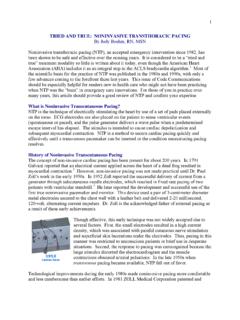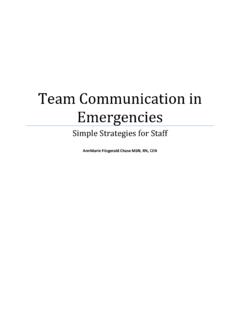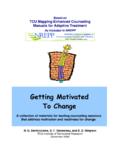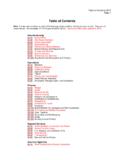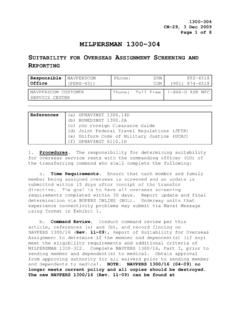Transcription of Mock Code Training” - ZOLL
1 1 mock code training AnnMarie Fitzgerald Chase, RN, MSN, CEN Come quick, my husband, he s not acting right, something is terribly wrong! a desperate Mrs. Smith shouted to Joe, the new staff nurse. Joe s heart started to pound. I just left him, and he was fine, he thought to himself. code 99, Medical 5, code 99 Medical 5, the operator announced overhead. Everything seemed to move in slow motion for Joe as he followed Mrs. Smith into her husband s room. Mr. Smith, a 45-year-- old patient admitted the night before for chest pain, lay unconscious in the bed as the nursing assistant was trying to rouse him. Joe s thoughts raced, What do I do now? I am not ACLS certified. Where is that code team?
2 Joe tried to remember back to his training . How does your facility prepare staff for these situations? When the patient s life depends on the quality of your staff s response, having competent staff is imperative. One way to maintain staff competency is through an annual review of equipment and procedure. This article will review code training , including mental preparation, content, tips for running mock codes and tools to assist in staff evaluation. The old healthcare adage says, during a code check your own pulse first. This is said in jest, but also acknowledges the very real fear of freezing up in an emergency. By mentally preparing for code situations, and by training staff to deal with the uncertain nature and emotional aspects of resuscitation, some of the anxiety around codes can be decreased.
3 Staff should be assured that it is normal for their hearts to race and their hands to shake as they feel the effects of adrenalin on their bodies during an emergency. They may feel as if they are frozen and unable to act when coming upon a patient who is in arrest. One way to overcome this is to simply take a deep breath. This small action can restore a sense of calm. Staff should be reassured that, once they summon help, it will arrive and they will not be alone. Encourage staff to use the techniques of visualization to remember what to do. Ask them to think about Mental Preparation 2 their biggest fear during a code . For most, it is a fear of not knowing what to do, where equipment is, or how to use it.
4 For some it is dealing with death or crisis or a specific population, such as pediatrics. Once they can identify what their obstacles are, they can work on addressing it. Even for those who do not have a fear of codes, mentally rehearsing the steps they would go through in a resuscitation situation will reinforce prior knowledge and build confidence. For instance, ask, What would you do if you found a patient unresponsive in the bathroom? Now list the steps. Model the critical thinking out loud for the audience. Encourage active participation by asking questions. Do they know how to call for help? Does everyone know where the code cart and defibrillators are on the clinical units? Can everyone operate the defib and attached the electrode pads correctly?
5 Mentally rehearsing the steps ahead of time is a powerful antidote to fear. If staff members are afraid of a pediatric code in particular, have them list out loud what the initial steps would be if they found a child unresponsive. Does the facility use a pediatric system such as Broselow-Luten system? Does the staff know how to use a Broselow tape? Do they know to use the resuscitation equipment such as an oral airway and bag-valve mask? If the answers are no, it is time for hands-on mock code training . Visualization techniques are an easy way for the staff to practice on a routine basis on their own. Encourage staff to seek out the answers to the questions that arise during these mental rehearsals.
6 Eventually, all direct patient caregivers will have to deal with a resuscitation situation, and should be prepared to deal with end-of-life issues, as less than 17% of inpatient cardiac arrests survive (Howard & Steinmann, 2010).1 Discussing your hospital s policy on family presence will open up the topic for further clarification and will identify your facility s resources to help the patient & family. A few questions to consider would be: Does your hospital have spiritual counselors or clergy available? Does the staff know how to contact them to support the family through this time of crisis? Does your hospital conduct debriefing for the staff? 3 Debriefing sessions with a mental health counselor can help providers deal with the powerful emotions that arise from dealing with intense and sometimes tragic situations.
7 If your hospital provides this service, make certain all staff are aware of the process. The following are a few scenarios that can assist in training staff to respond more effectively during an emergency. The beat goes on Somebody help me are the chorus lyrics to Rihanna s pop hit (Rescue Me) 2. What do this song and The BeeGee s classic 70 s hit Stayin Alive 3 have in common with code training ? Other than their resuscitation-related titles, both songs are musically written to contain approximately 100 beats-per-minute. Since 2005, 100 compressions per minute has been the AHA recommended rate of CPR. Most healthcare employees enroll in a BLS class as a requirement of their job, but often forget the rates soon after the class, as it is used infrequently.
8 Performing CPR properly may increase survival rates for cardiac arrest three-fold (Matlock, Hafner, Brokewitz, Barker & Dewar, 2008)4. CPR: What s that rate again? 4 Use these songs as a creative way to reinforce the proper rate for CPR. One pilot study has demonstrated that students who trained with the song Staying Alive performed CPR at the correct rate initially as well as long term (Matlock, Hafner, Brokewitz, Barker & Dewar, 2008)4. These two songs span our multi-generational workforce too, as most people are familiar with one or the other. Try tapping out the beat while practicing CPR on a mannequin. Encourage singing during training . Turn on the music when staff is practicing CPR, and it will soon liven up the room.
9 Mixed population Do you have biphasic defibrillators, monophasic defibrillators, or a combination of both in your hospital? Most hospitals have upgraded to the biphasic models, but others may keep a mix of both types. If your hospital has both, make certain that ACLS trained staff understand the difference and the recommended joule settings for each. vs. Know Your Equipment Quick CPR Review Rate: 100 compressions per minute: 5 cycles lasting approximately 2 minutes Compression to ventilation ratio: Adult: 2 person HCP 30:2 Pediatric: 2 person HCP 15:2 *For adults with advanced airway in place: Asynchronous, compression 100 per minute, ventilation 1 breath every 5-6 seconds, delivers 10-12 breaths per minute.
10 5 For all ZOLL biphasic models, the initial energy setting starts at 120J, and then increases to 150J and 200J for subsequent shocks (refer to your specific model s operating manual). Monophasic defibrillators require 360J for initial and subsequent shocks for adult patients (AHA, 2006)5. If you have multiple models of defibrillators and are unsure if they are monophasic or biphasic, call Biomed or the manufacturer. If you have multiple types of defibrillators, a quick way to visually remind staff of the appropriate settings is to label the units with the correct energy levels. Remind learners of the need to remove any medication patches.



